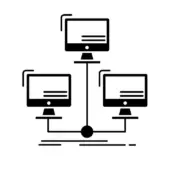Advanced customer retention strategies increasingly focus on both the user experience (UX) and customer experience (CX). While these concepts interrelate, they are distinct from one another. For instance, UX primarily focuses on how customers and leads interact with your digital interfaces. It covers such elements as:
- Website design, aesthetics, and usability
- Information Accessibility
- Ease of navigation
- Cross-platform compatibility
Meanwhile, CX covers a consumer’s overall impressions of a company or brand including pre-purchase, consumption, and post-purchase. It covers brand perception, customer service, and both the nature and quality of all direct interactions with a business or its products. These interactions are collectively known as touchpoints.
UX and CX are key elements of a consumer’s digital experience with a company and its products or services. Given their shared importance, customer retention strategies prioritizing both UX and CX—and their interactions—can reduce attrition and build higher customer loyalty.
Use this guide to combine UX and CX and build a better overall experience.

Understanding the Intersection of UX and CX
While interactions between UX and CX are complex, the general nature of the relationship between the two concepts is quite straightforward. UX is a sub-component of CX. Simply put, businesses that can’t build a frictionless user experience won’t generate a positive customer experience.
Sometimes, a product can deliver a good user experience while the company or brand produces an underwhelming or flawed overall customer experience. For example, a commercial website might have a well-designed and intuitive interface but a cumbersome and time-consuming onboarding process. Such situations are more likely to lead to abandonment and lower conversion rates.
Meanwhile, a business delivering a great CX but with an underperforming UX can produce similar results. Say a business provides friendly, detailed, and helpful customer service but suffers from an outdated website or design flaws in its digital interfaces. This can leave customers frustrated and seeking alternatives.
Bringing CX and UX Together for Customer Retention
Customer retention strategies that bridge CX and UX can create holistic customer journeys that drive satisfaction and encourage repeat business. To achieve this, businesses should:
- Give the Customer a Voice: Perform user research that builds empathy for customers. Through methods like user interviews, surveys, and usability testing you can get a better picture of who your customers are, the goals they are trying to accomplish, typical behaviors, and pain points they encounter along their journey.
- Create and Test User Personas: User Personas, fictional yet data-driven representations of specific user segments, provide detailed profiles to understand and empathize with your target audience. You can reference user personas throughout the design and development process or guide those characters through a test journey to determine how they would react to your current interfaces. Apply the insights you gain to improve both your UX and CX.
- Use Journey Mapping: Journey mapping creates a visual representation of your persona as they engage with your organization through key touchpoints across multiple channels. Dividing the overall CX into specific, individual interactions, enables you to enhance and optimize each key touchpoint along the path and uncover the largest opportunities for improvements.
UpTop Perspective
Two questions that business leaders should ask cross-functionally are: 1) How can we make it easier to do business with us? 2) How can we help customers accomplish their objective faster, with less effort?

3 Customer Retention Strategies to Improve CX Through Excellent UX
Though distinct and unique, UX remains a critical component of CX. Businesses can improve the customer’s overall experience by focusing on key elements of the user experience. These include:
Reducing Friction in Customer Experience
In UX, “friction” refers to any element or aspect of a design that creates obstacles, problems, or difficulties for users. In business-to-consumer (B2C) settings, common examples of friction points include:
- Needlessly complex website navigation
- Slow loading times
- Limited information about products or services
- Complex or convoluted checkout processes
- Earning trust with consumers
In business-to-business (B2B) settings, friction frequently occurs through:
- Overly technical or complex product information
- Complex navigation and inconsistent naming, categorization, and labeling
- Limited evaluation tools
- Cross-platform incompatibility
- Having too much gated content
Retention plans focused on building a better customer service experience prioritize reducing UX friction. Use these key strategies to build a frictionless customer experience:
- Optimize website layouts to make it easy for users to move through the various steps in the buying process
- Create a faster experience by limiting or removing high-resolution images and graphics
- Minimize the number of clicks and steps a user must go through to complete their shopping journey
- Collect only strictly necessary data and information
- Support multiple payment methods so customers can complete transactions with their preferred option
UX designers also seek to optimize what is known as “micro-interactions.” Small details, such as status visibility, error diagnostics and prevention, and interface consistency, can have an outsized impact. Don’t overlook them as important aspects of customer retention strategies.

Empowering Customer Self-Service
According to Gartner, 70% of customers use digital self-service tools during their purchasing journeys. This high percentage speaks to the importance of emphasizing self-service in your customer retention strategies. In fact, customers increasingly rely on self-service to perform research, order products, and resolve issues or complaints.
Important elements of a retention strategy built around a high-performing self-service model include:
- Content that’s easy to find
- Accurate, user-friendly search tools
- Personalized recommendations based on collected user data
- Artificial intelligence (AI) enhancements to improve accuracy and usability
Also, remember that you can harvest deep, impactful insights by following customers along their self-service journeys. Assess where your system supports self-service well and where it leaves room for improvement.
UpTop Perspective
Start by offering self-service options for tasks that are relatively simple and commonly requested. This could include account management, basic troubleshooting, or answering frequently asked questions.
Measuring the Impact of UX on CX
Data-based metrics that help you measure the impacts of your UX design on your CX outcomes are essential. While website analytics can pinpoint issues, conducting qualitative research, such as customer interviews or usability testing, can provide insights into the underlying reasons behind certain behaviors. This deeper understanding enables you to address the root causes of issues to improve your CX.
Additional UX metrics that impact CX include:
- Time on Task: Generally, the less time a user spends completing a task, the better.
- Task Success Rates: When users complete tasks at high rates, it indicates UX success.
- Error Rates: When errors are consistently associated with specific steps or tasks, the underlying UX may need improvement.
- Drop-Off Rates: Drop-off rates measure the percentage of users who abandon your conversion funnel. High rates can indicate UX problems or fundamental flaws in your call to action.
- Conversion Rates: Conversion rates measure the percentage of users who complete your conversion funnel. High rates often indicate a successful UX design.
Improving your customer retention strategies demands a close and thorough analysis of UX and CX interactions. These tools can guide you to invest your time and resources to boost the performance of specific, high-impact user experience and customer journey elements.
Build Better Customer Retention Strategies With UX and CX
The changing demands of a highly competitive digital commerce landscape mean businesses must master both UX and CX. With a strong UX design, you can create a customer experience that inspires loyalty and engagement.
Through careful, research-driven UX design, we have helped dozens of clients improve their commercial performance and build a superior customer experience. Our experts deliver deep, impactful insights personalized to each client’s unique needs and situations.
Contact us today to discuss ways to improve your UX to support a better CX.


